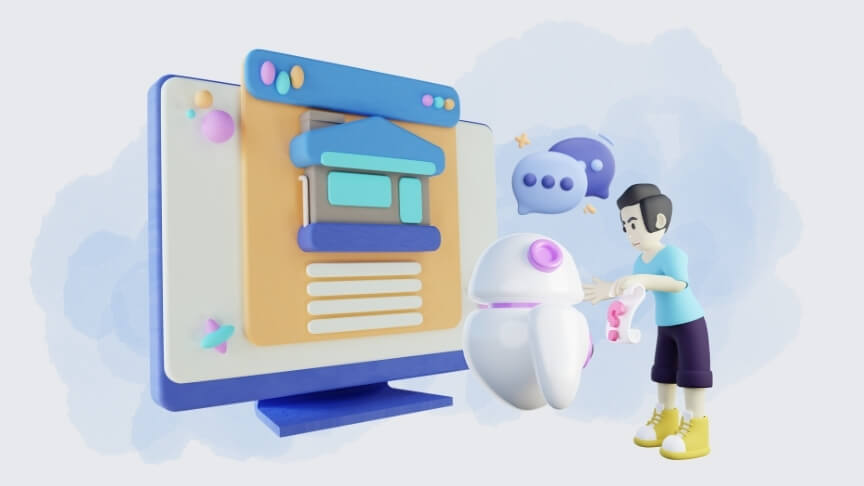
How to Integrate Chatbot on Your Website in 3 Easy Steps
Website interactions have significantly transformed over time. Offering excellent website browsing experiences is one of the indispensable areas that businesses cannot ignore. So, how can you build these seamless experiences for your consumers?
Interactive website design? Yes.
Visually appealing images and videos? Yes.
Attractive color scheme? Yes.
Seamless navigation? Yes.
Responsive design? Yes.
Excellent content quality? Yes.
Another aspect/tool that contributes to providing a memorable website experience is chatbots.
Chatbots are known to enhance customer support, streamline lead generation, and improve overall consumer satisfaction.
In this post, we will learn more about these website chatbots and their application in various business functions. We will also learn how to integrate a chatbot on your website in 3 simple steps.
What Is a Website Chatbot?
A website chatbot is a chatbot that is specifically designed to communicate and engage your website visitors. These chatbots simulate real-life conversations with your website audience providing them with desired information, answering their questions, and helping them with various tasks. By mimicking human behavior, chatbots help you connect with your website visitors and build an amiable relationship with them.
The goal of website chatbots is to enhance user experience while streamlining communication. They are able to achieve this because of their built-in functionality that is designed to make websites more engaging.
- Information Presentation - Chatbots can provide website users with information about your products, services, operational processes, and more. They can fetch relevant details and present the same to your audience in a conversational format.
- Customer Support - Chatbots can offer immediate customer service by handling common queries, troubleshooting issues, sharing product recommendations, and more. They can also escalate complex queries to human agents as and when required.
- Task Automation - Chatbots can automate routine tasks, such as booking meetings, scheduling demos, making reservations, and more. This helps save your time and that of your website visitors.
There are two types of website chatbots available today - rule-based chatbots and AI-powered chatbots. As the name suggests, rule-based chatbots (commonly known as answer bots) handle common queries and frequently asked questions. They will merely follow the rules they are built with. In comparison, AI-powered chatbots leverage artificial intelligence, machine learning, and sentiment analysis algorithms to interact with the audience. They are equipped to handle complex queries, guide visitors to make purchase decisions, and more.
Chatbots had never been like this before. The rapid technological advancements have transformed chatbots and their functions altogether. That being said, let us quickly explore the history of website chatbots in brief.
History and Evolution of Chatbots in Web Environments
The first chatbot was developed by Joseph Weizenbaum, a professor at MIT in the 1960s. ELIZA, as the chatbot was named, was a computer program that simulated conversations. However, ELIZA was not coherent.
Years later, Mitsuku was designed by Steve Worswick. It was one of the first most human-like chatbots ever developed. The following years saw the advent of natural language processing technologies that played a critical role in building more sophisticated chatbots. Companies started leveraging artificial intelligence to develop smart chatbot applications to facilitate seamless conversations.
Chatbots have become a part and parcel of every business today. They are deploying chatbots on their websites to engage visitors and offer them pleasing brand experiences.
Website chatbots have come a long way since their inception. From simple conversation simulators to powerful platforms that identify visitor intent and offer them an optimal solution, website chatbots are changing the face of the customer engagement industry.
Benefits of Adding a Chatbot to Your Website
Chatbots play a significant role in improving customer communication and engagement. Integrating a chatbot with your website offers a multitude of benefits. Here are a few of them.
- 24/7 support - Chatbots operate round the clock thereby ensuring continuous support to visitors even outside of regular business hours. With chatbots, you can offer assistance to all of your website visitors irrespective of the time zones they come from. It helps you become available for your consumers even when your human agents are offline. This helps you deliver the right attention and necessary help to your consumers when they look for it and strengthens their loyalty toward your brand.
- Improved response time - Chatbots are designed to offer instant assistance to website visitors. They can provide immediate responses to their queries. They can also handle large volumes of queries simultaneously without causing any delay in sending relevant responses. This creates a better user experience as they no longer depend on human agents for query resolution. In fact, 74% of customers prefer using chatbots to look for answers to simple questions.
- Multi-language support - Chatbots help you break the communication barriers with their multilingual support feature. It can converse with customers who speak different languages and guide them through their questions. This helps you cater to an entirely new section of potential customers in their local language and increase your customer base.
- Cost savings - Although implementing website chatbots requires upfront investment, they can help you save money over time. By taking over simple routine tasks, chatbots help you address more customer queries without having to hire additional staff.
- Less room for error - Chatbots work on carefully planned algorithms and databases to provide accurate answers to customer queries leaving no room for error. Unlike human agents, chatbots do not get distracted at work or forget to include important details while sending responses to customers.
- Enhanced team productivity - Chatbots reduce the workload on human agents by handling routine queries, automating repetitive tasks, and streamlining workflows. By taking over mundane work, chatbots free up your human agents' time to help them concentrate on more strategic and value-adding business-related activities.
Chatbots initiate engaging conversations with your website visitors and play a crucial role in streamlining their experiences with your brand. Integrating chatbots on your website helps you streamline various functions of your business for driving sales and boosting revenue. Let us understand how to add a chatbot to your website in the next section.
How to Add a Chatbot to Your Website?
Integrating a chatbot on your website can be done in two ways - building a chatbot from scratch and utilizing a third-party chatbot software. The former method of building chatbots is quite tedious and expensive. However, the second method i.e. using an external chatbot builder is cost-effective, user-friendly, and does not require you to have advanced technical skills.
Before you start adding a chatbot to your website, it is important to identify the reasons for the integration. Identify the purpose of your chatbot and outline your goals. List down all the business functions and tasks that need to be automated. Is it customer support automation, lead generation, or streamlining user experiences? Research how a chatbot can fit into this picture and perform these activities for you. This will give you a clear picture of the type of chatbot you need and the features it must possess.
Do not forget to decide on a place on the website where you want the chatbot to appear. Ideally, the lower right corner of the page is the best position for placing your chat widget.
Once the purpose of the chatbot and its position on the website are decided, it is time to choose the right chatbot platform for your business.
Choosing the Best Chatbot Platform
Here are the key considerations to keep in mind before shortlisting a chatbot platform for your business.
- Features - Research the platform's functionality and assess how this functionality can help you achieve your business goals. Some of the must-have features are easy chatbot creation, quick chatbot configuration, interactive chatbot workflows, seamless live agent handover, eCommerce personalization, hassle-free integration with other third-party apps, chatbot analytics, and more.
- Scalability - Ensure that the platform is equipped to handle large volumes of consumer queries. It must grow and adapt to the changing requirements of your business without causing any bottlenecks.
- Cost - Evaluate the pricing structures of the platform. Research if these plans entail any transaction costs or additional charges for advanced features. It is ideal to choose platforms that offer a free trial period. This will help you test the platform's suitability for your business and its performance before you actually buy its subscription.
Introducing Bodt.io
Bodt is an AI-powered conversational chatbot designed for websites to automate customer support, boost engagement, and convert website visitors into active customers.
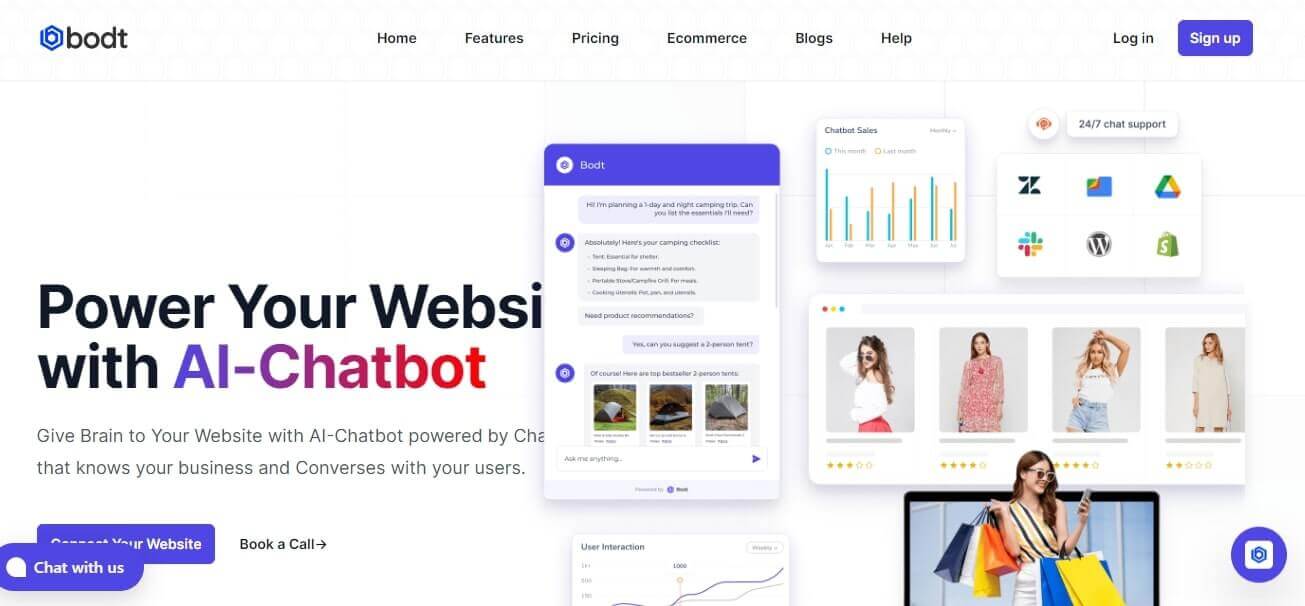
It offers an intuitive chatbot builder for creating your chatbots and amazing features to take your customer support to the next level. You can build customized chatbots to offer solutions to customers’ queries.
Bodt helps you build excellent chatbots that offer accurate responses to complex conversations without any human intervention. These chatbots can be configured to share personalized product recommendations, concise product-related information, policies and documentation, and much more. You can also configure a lead form in Bodt to capture visitor information.
Bodt allows you to add custom FAQ content to deliver the right solution to specific consumer queries. It offers a simple question-answer interface to add the desired question and its respective answer to the query.
Bodt allows up to five chat prompts on your website that can be shown to your visitors.
Bodt Chatbot Integration - A Step-by-Step Guide
Here is a quick 3-step guide to build an intuitive chatbot using Bodt.
Step 1
Create an account with Bodt using your work email, Google account, or GitHub account. Complete the registration process by entering information about your business and finish your account setup.
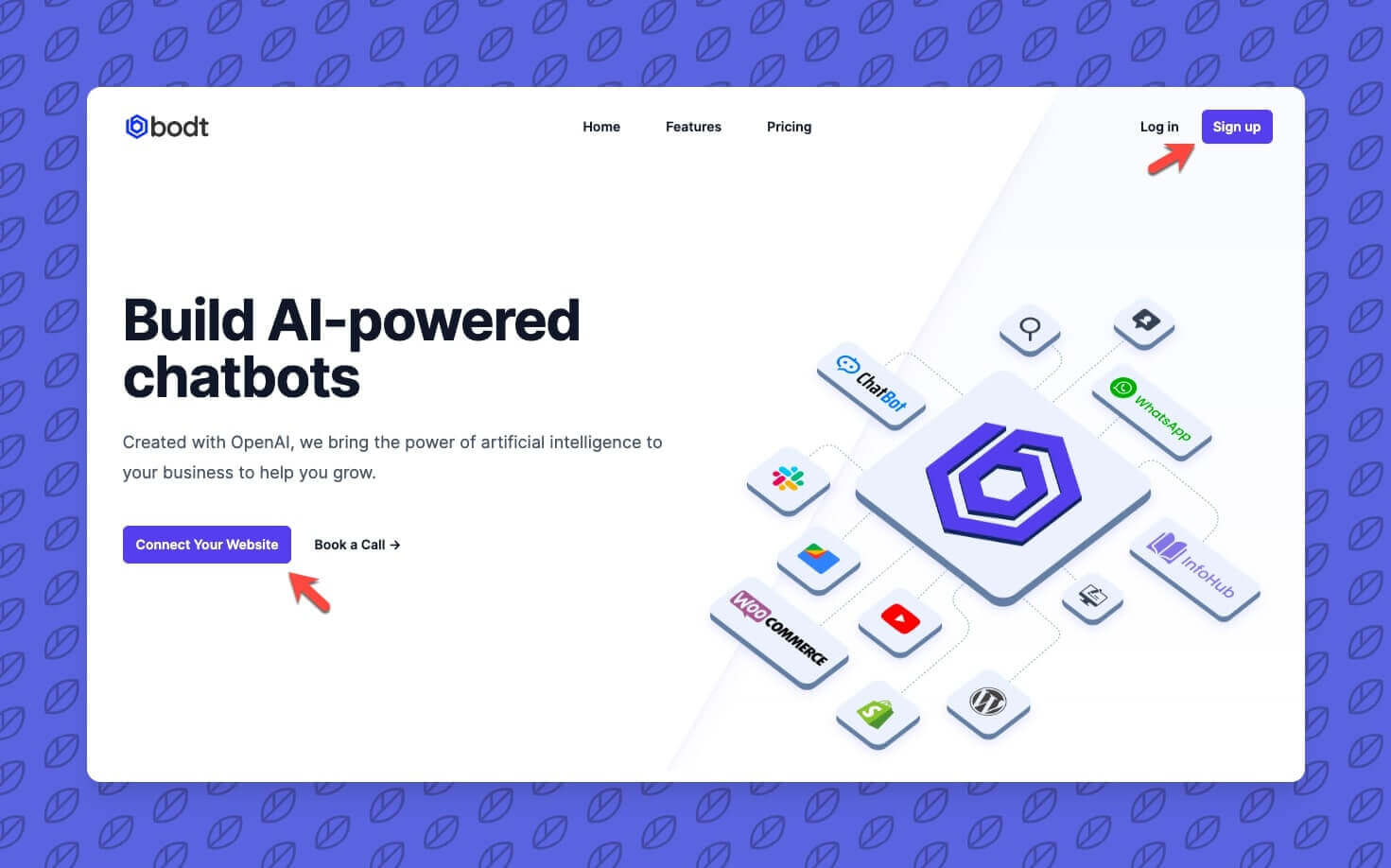
Step 2
Add your website URL or sitemap URL to the Bodt application and wait for it to fetch all URLs from your website. Choose a handful of links (maximum 50 links allowed at this step) and move towards training the chatbot. This step will train the Bodt's AI model with your data.
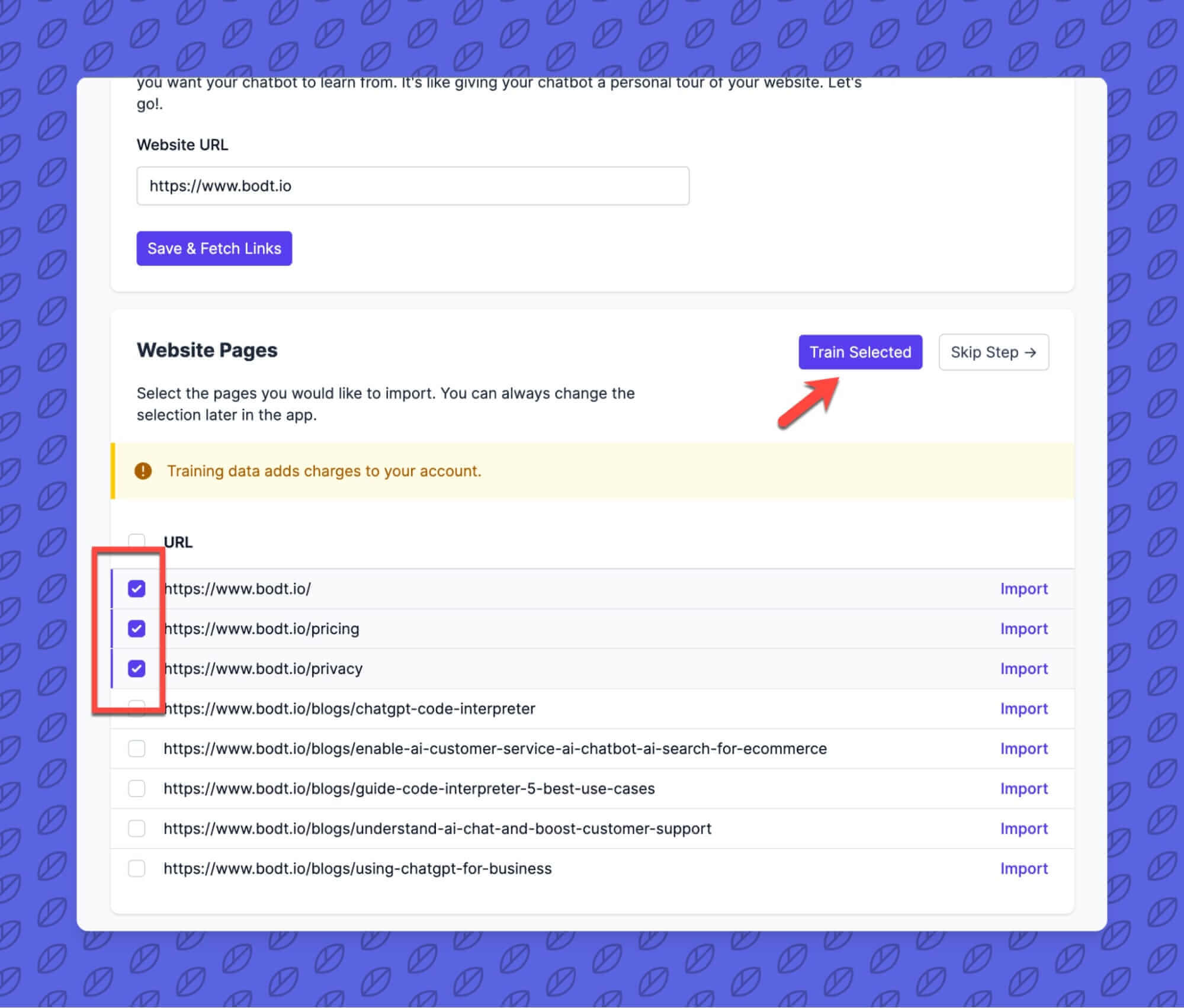
Bodt offers smart AI models that can use data from regular websites, Shopify, WordPress, Wix, Magento 2, GitBook, Zendesk, and other web-based CMS platforms. Besides, Bodt supports data from docx files, doc files, pdf files, and text files for training the AI models.
Step 3
Now, it is time to configure your chatbot widget and embed it with your website. Upload your logo by entering a media URL and enter the color code (hex code) of your brand theme. Select a color for the textual content and write down your first welcome message. To make the chatbot live, you will have to opt for a subscription plan.
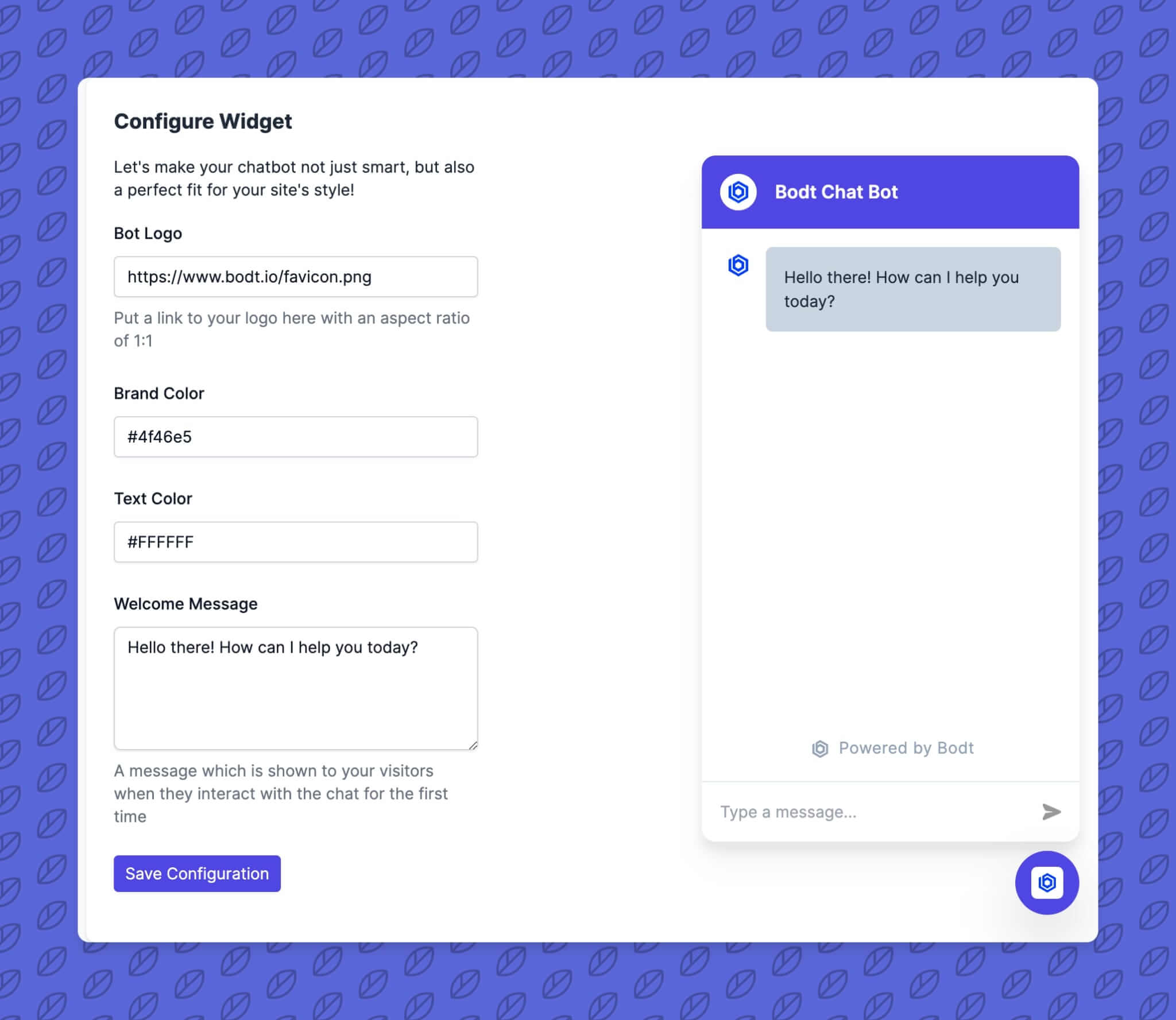
Bodt will generate a custom code that you will have to insert in the tag on your website with the help of the IT team.
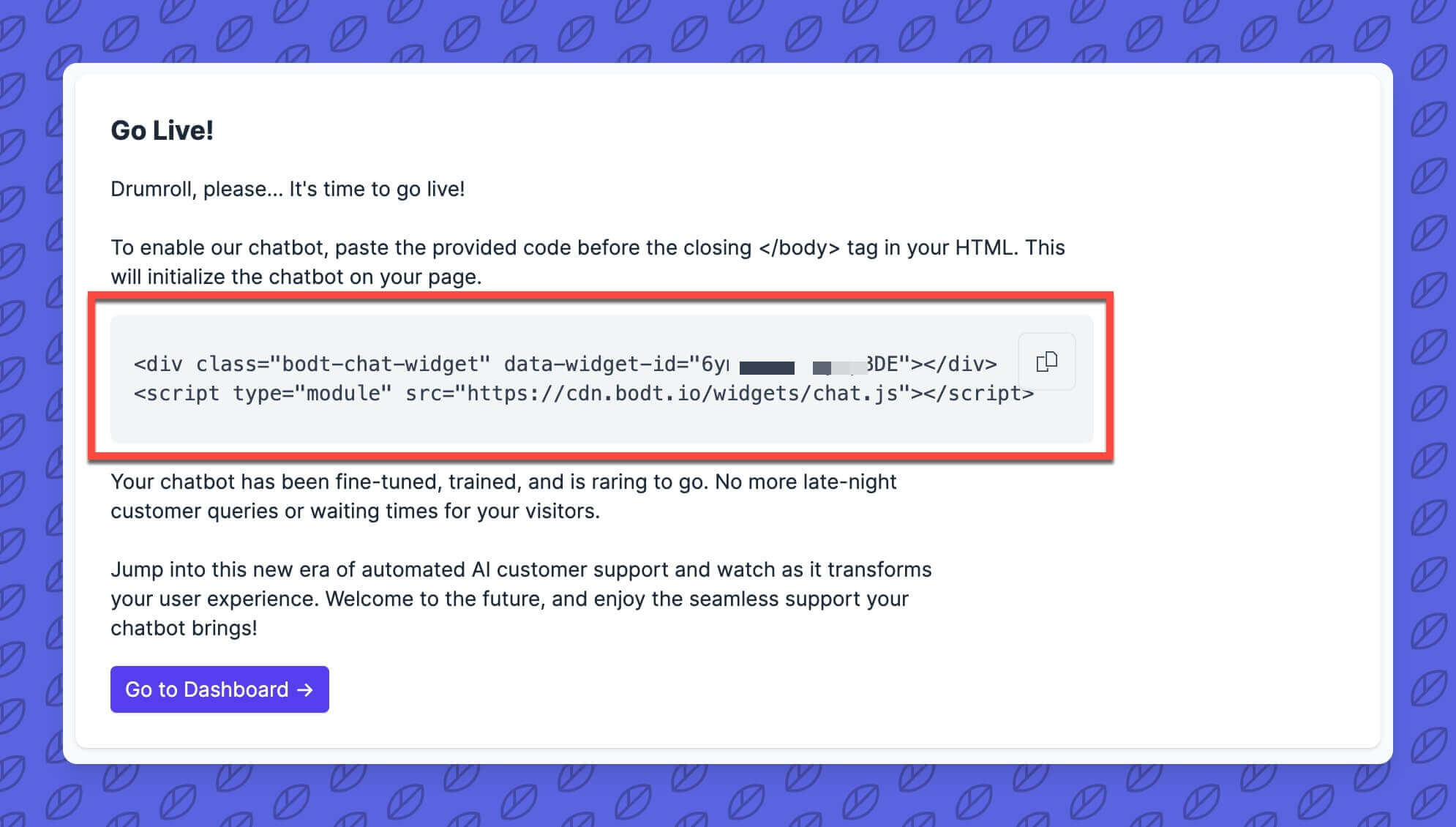
Your newly configured Bodt chatbot is now ready to serve your customers.
What Are the Different Functions Chatbots Can Perform for Your Business?
Here are a few areas where chatbots serve as a powerful solution to improve customer satisfaction and retention.
#1. Customer Support
Chatbots handle customer queries and offer them quick and consistent customer support experiences. They leverage your existing resources, such as knowledge base articles, FAQs, website copy, and more to simulate human-like conversations and resolve your customers' questions. They are designed to support customers around the clock and handle routine queries efficiently. In the case, if they encounter any complex queries, they route it to your human support agents for further intervention.
Amazon, the most popular eCommerce platform, leverages an AI chatbot to resolve large volumes of customer issues. The customers can initiate a conversation with the bot and select from the list of available common queries or type in their unique questions. Rather than making customers wait for hours to receive a response, Amazon's automated chatbot resolves their queries in just a few minutes.

#2. Appointment/Meeting Scheduling
Chatbots offer a user-friendly interface to your website visitors to book, reschedule, or cancel their appointments or meetings. These chatbots are integrated with your team's work calendars ensuring they provide real-time availability information about your team and prevent any scheduling conflicts. As they are available 24*7, your consumers can book their appointments at any time of the day.
Further, they can send automated reminders and confirmations about the meetings to reduce the possibility of meeting no-shows. By delegating appointment scheduling to chatbots, you can manage your appointments efficiently and increase the operational effectiveness of your business.
Sephora leverages its chatbot for scheduling makeup appointments or custom makeover sessions for its consumers. It simplifies the appointment scheduling process and helps consumers book their sessions without any hassles. It does so with the help of an embedded calendar and eliminates the friction of the session booking process.
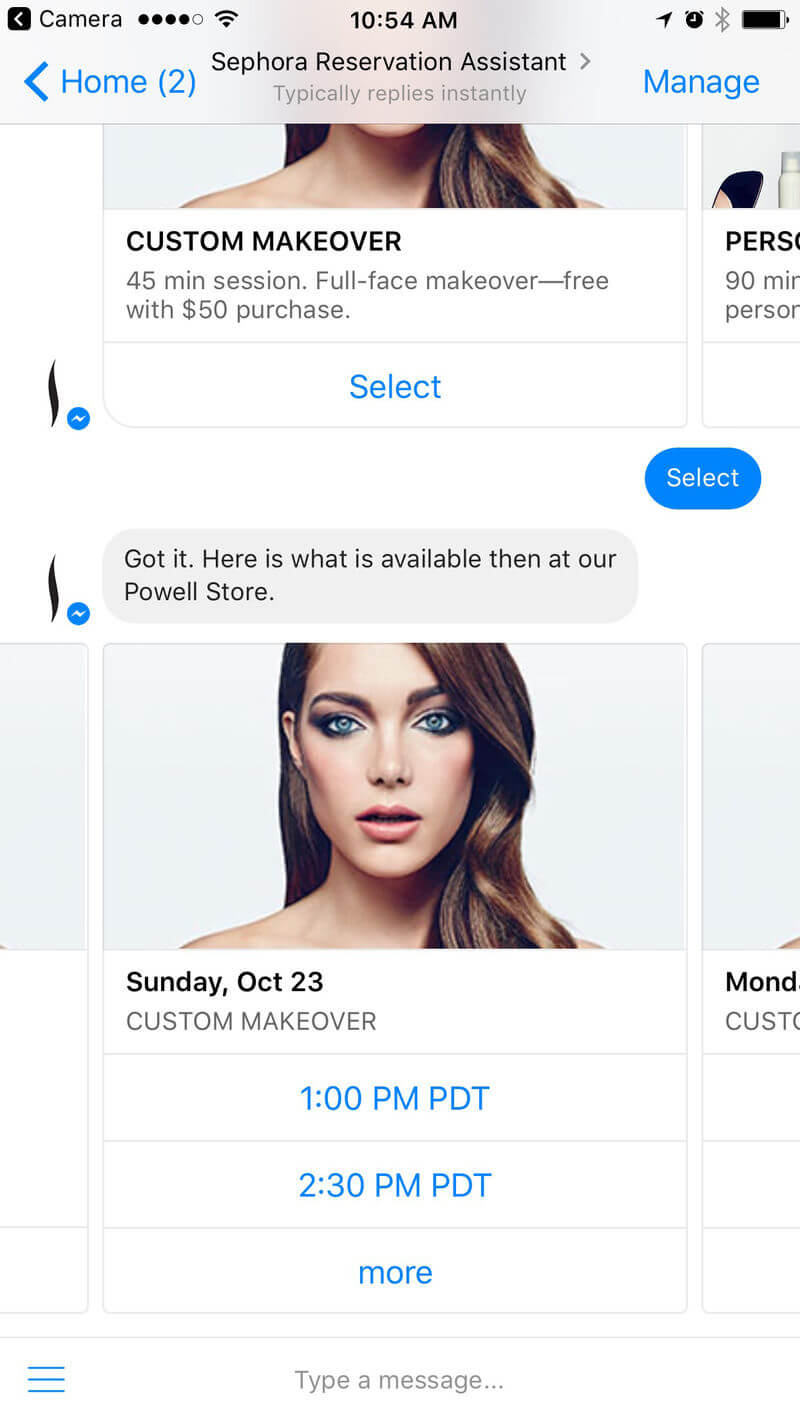
#3. ECommerce Personalization
Chatbots, especially AI-powered ones, are equipped to analyze consumer behavior and their preferences to deliver personalized shopping experiences to them. Using AI, machine learning, and natural language processing algorithms, chatbots can offer tailored product recommendations, personalized offers, dynamic pricing, and more. This helps you align your offerings with the consumer's interests and design a customized journey for each of them thereby making online shopping a more enjoyable experience.
H&M's chatbot questions its consumers about their clothing styles and suggests personalized product recommendations accordingly. The chatbot starts by sending pictures of the outfits to the consumers and asks them to choose the one that matches their style. Based on the consumer's response, it searches for potential matching products in the store and presents them to the consumers. It plays the role of a virtual stylist by sharing personalized product suggestions with the consumers.

#4. Lead Generation
Chatbots help you with lead generation by gathering desired customer information, engaging them in meaningful conversations, and qualifying them as leads. They help you identify potential customers and cultivate a relationship with them.
As chatbots readily integrate with your CRM systems, you can manage lead information efficiently and devise interesting strategies to enhance the lead nurturing process. Some of these strategies include - understanding customer requirements, sharing educational resources, promoting new products, sending limited-time offers, offering incentives or rewards, and more.
Kiehl's, an apothecary skincare, body, and hair care brand, utilizes a chatbot to capture consumer details and give tips regarding skin concerns, hair care, and more. Once it gathers the necessary details, it offers personalized beauty consultations based on individual skin types while explaining the benefits of the products.

#5. Customer Feedback and Surveys
Chatbots can capture consumer feedback by delivering questions in an engaging manner. Instead of sharing a link with a long questionnaire, the chatbot shares one question at a time thereby making feedback collection more efficient. As consumers are not bombarded with lengthy questionnaires and chatbots allow them to complete the survey at their convenience, consumers are readily participating in surveys and sharing their feedback.
Chatbots can also follow up with those customers who have not shared their feedback with the help of gentle nudges now and then.
Billie, a chatbot by IKEA is designed to help consumers with store locations, order statuses, rescheduling deliveries, and more. After every conversation, Billie asks for feedback on how well she is doing. The main goal of this feedback is to train and improve Billie.
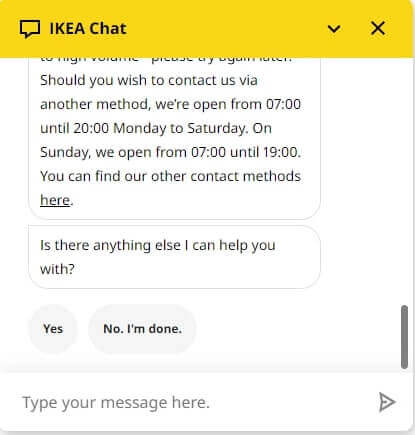
Best Practices and Tips for Chatbot Integration
Here are a few tips you can follow to ensure your chatbots deliver the best performance.
- Keep the chatbot's knowledge base (data sources) up-to-date at all times. The chatbot should always have access to accurate information.
- Leverage machine learning algorithms to train your chatbot on visitor interactions and improve its response quality. Bodt is an AI-powered chatbot that utilizes machine learning and sentiment analysis to understand visitor queries and their intent better.
- Configure your chatbot to deliver messages that demonstrate some empathy and personality rather than some robotic experiences.
- Enable live agent takeover to ensure complex queries are being addressed at the right time.
- Conduct regular testing to identify any issues in the chatbot workflows or functioning and address them promptly.
- Do not hesitate to ask your customers for feedback about their experience with the chatbot. This will help you identify areas of improvement and build a bot that is more helpful for your website visitors.
- Track your chatbot performance on a regular basis to measure visitor engagement, identify consumer behavior patterns, and more.
Conclusion
There is no doubt website chatbots play a crucial role in enhancing consumer experiences and streamlining various business functions. From customer support to lead generation, chatbots have automated repetitive tasks allowing you to focus on other important business activities.
As technology continues to evolve, chatbots will see greater advancements with the ability to provide more sophisticated, precise, and relevant experiences.
Our product, Bodt is one such chatbot platform that is powered with continuous technological developments for building contextually-aware bots to deliver engaging online experiences. Get started with Bodt to revolutionize your customer interactions using ground-breaking technology.
